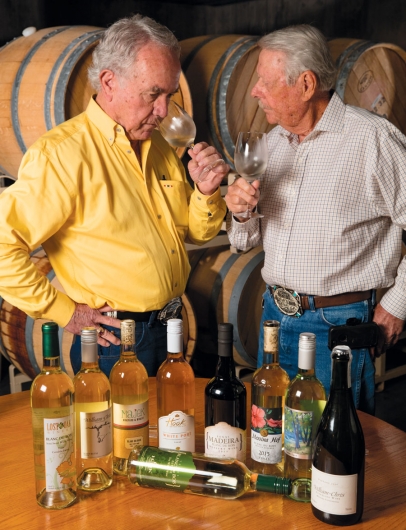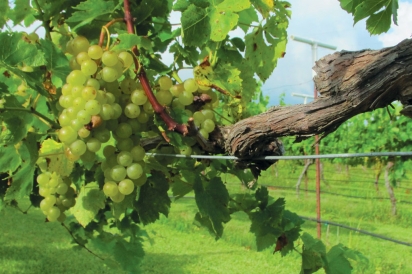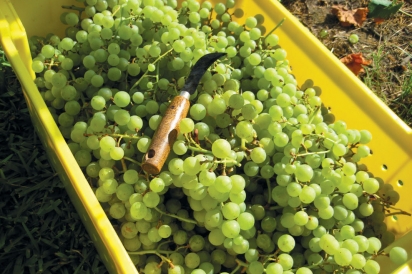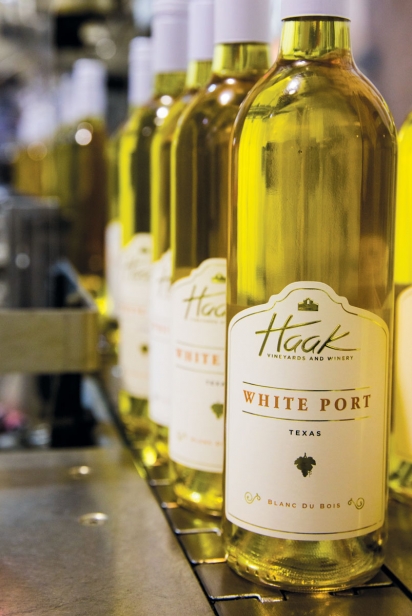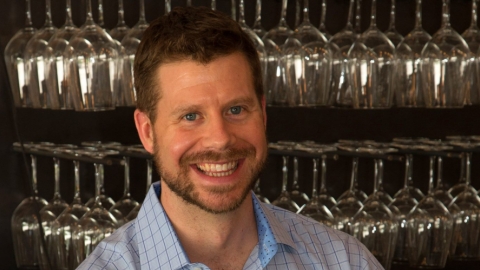Blanc Du Bois: Texas Grown
Friendships Fertilize Success of Local Grape
When my wife, Gladys, and I opened our winery in 2000 in Santa Fe, just south of Houston,” recalled Raymond Haak, “I invited then-Houston Chronicle wine writer Michael Lonsford down to visit. Afterwards, he wrote a nice story on us in the paper and I was particularly pleased by the really great things he said about our Blanc Du Bois wines.”
Today, Haak cherishes a string of moments like this garnered in Texas, California and abroad. He has a wall full of medals from national and international competitions for his Blanc Du Bois wines made in many styles from dry to sweet. They tell him that he found something special in this once-little-known grape.
Despite its French-sounding name, Blanc Du Bois is not actually a European wine grape, but is a hybrid grape that came to Texas via Florida. John Mortensen, PhD, born in Texas and later a University of Florida professor, helped developed Blanc Du Bois. In 1987, he released this hybridized wine grape especially suited for hot, humid Southern climes. He named it ‘Blanc Du Bois’ (with both capital “D” and “B”) in honor of Emile DuBois—who, in 1882, came to Florida from France and became an accomplished grape grower and winemaker in the Tallahassee area.
The breeding programs that culminated in Mortensen’s Blanc Du Bois go back more than half a century to 1945. During that period, the process included two crosses with a Floridian grape known for its resistance to Pierce’s Disease (often called PD), a disease common in warmer Gulf Coast regions like Florida and Texas. However, its winemaking potential goes back even further with a Blanc Du Bois ancestor grape: Pixiola. It was crossed with Golden Muscat, a grape with still older lineage to Muscat of Hamburg and Muscat of Alexandria, both Vitis vinifera, winemaking grapes of Europe.
According to Mortensen’s 1987 release circular, “Blanc Du Bois makes a spicy white wine which was rated very good in formal wine tasting panels.” In fact, in those trials, wine made from Blanc Du Bois outperformed all of the white hybrid wine grapes put up against it.
Since the release of Blanc Du Bois in 1987, its story and assimilation into the commercial wine world took a shift to Texas. It was around this time that two men in the greater Houston area, Haak and his soon-to-be-friend Jerry Watson, started experimenting with growing Blanc Du Bois on the Texas Gulf Coast.
Haak had already delved into grape growing and winemaking as a hobbyist going back to 1969. In the late-1980s, Haak read a trade journal article on Blanc Du Bois, now more commonly referred to in Texas as simply “Blanc.” “So, after reading that article, I ordered a few vines to add to my vineyard. It seemed like before I knew it, Gladys and I had several acres of Blanc growing in our estate vineyard in Galveston County,” he said.Watson had his own story that coalesced with Haak’s. He said, “My wife, Cozette, and I decided we would grow grapes. After hearing about Blanc from Texas A&M horticulturalist Dr. George Ray McEachern, I called Dr. Mortensen and he told me he had some Blanc Du Bois cuttings I could have. So I planted these 36 cuttings and about a year later we planted our first acre of Blanc on our property in Cat Spring in Austin County.”
Watson continued: “Raymond and I first met at a statewide grape growers convention and started to share information about our experiences with Blanc Du Bois. Raymond was a home winemaker and I was experimenting with making wine, too. Mike McCann, a veterinarian who lived in Fulshear, also began growing Blanc around 1995. We all attended statewide meetings and those of us out west of Houston in Cat Spring started to hold annual grower field day meetings here and some focused on Blanc. As time went on, Raymond, Mike and I and our spouses became good friends.”
These friendships were put to good use when Raymond and Gladys Haak opened their winery. They developed a need for more Blanc Du Bois than he could grow. Watson and McCann continued to plant Blanc Du Bois and sold their grapes to the Haaks. In time, through friendly collaboration, they discovered the “Blanc Magic” of growing and winemaking with this grape that made wine judges and consumers take notice. This was information that they readily shared with regional Gulf Coast and east Texas growers and, more recently, with winemakers around Texas.
As a result, Lynne Majek and her husband, Randy, started their vineyard and winery in Moravia near Schulenberg. “We had already acquired some family land,” she said. “Along with our neighbors, we decided to start wineries like many Czech families did here in the 1800s. When I went to get a Texas Tech viticultural certificate, I became familiar with Blanc Du Bois and Fritz Westover, a viticulture consultant who has done a lot to help growers in our area.”
Karen Bonarrigo, co-owner of longstanding Messina Hof Winery in Bryan, said, “We recently found that Blanc Du Bois shows great promise making many styles of wine. We offer both dry Blanc Du Bois table wine and a sparkling cuvee. Its versatility yields many winemaking options, usually resulting in delightfully aromatic white wines that consumers like.”
A true testament to the success of our local Blanc Du Bois grapes came from Chris Brundrett, co-founder with Bill Blackmon of William Chris Vineyards in the hill country town of Hye. In 2007, Brundrett decided to go out on his own as a winemaker, setting his sites on making wine from European vinifera wine grapes. However, it was a very wet year and he couldn’t find any Texas vinifera grapes available.
Brundrett recollected, “After searching around, I finally found some Blanc Du Bois from a vineyard in Brenham. At first, I wasn’t too excited about making wine from a hybrid grape, but I was surprised to find out that this grape made a really nice white wine.”
It was through Brundrett’s first Blanc Du Bois experience that he met his now business partner Bill Blackmon. Brundrett said: “When I met Bill, the first thing he said to me was ‘Oh, aren’t you the kid with that great little Blanc?’ After that, we became fast friends. We think Blanc has something to offer wineries all over the state. It’s grown in a region [east Texas and Gulf Coast] not affected by late spring freezes that often disrupt the production of white grapes and wines in Texas. Blanc is generally available every year. Man, it’s a grape that really wants to be here!”
William Chris Vineyards now produces two Blanc Du Bois wines: one dry white blended wine called Mary Ruth that combines Blanc du Bois with vinifera grapes, and the other, a sparkling cuvee that is 100% Blanc Du Bois with grapes coming from east Texas. Brundrett said, “Lewis Wines just down the street from us makes a cool little vinho verde-style wine from Blanc Du Bois made bone-dry and slightly effervescent”.
Houston-based viticulture consultant Fritz Westover said: “Blanc Du Bois acreage has been on a rapid increase, doubling in recent years with now over 250 acres of Blanc Du Bois planted in Texas; more here than in anywhere else in the world. By far, most of it is grown in the Gulf Coast and east Texas.”
Gaining reputation and following, “Texas Blanc” appears to make good sense for our area and Texas as a whole. It’s good wine that we owe to the efforts of good friends: Haak and Watson.


